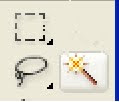So today I am going to tell you guys how to use the magnetic lasso tool. Follow the steps below and you will be perfect!
Step 1: Select the Magnetic Lasso Tool from the Toolbar.
Step 2: Set any desired option from the options bar.
Step 3: Click to set the first endpoint of the selection.
Step 4: To draw a freehand segment, move the mouse pointer along the edge you want to trace. (You don't have to hold down the mouse button, although you can if you like.)
Step 5: As you move the pointer, the selection will automatically snap to the strongest edge in the area around the pointer, based on the Width set in the Options Bar. Periodically, intermediate points are added to the selection border. While tracing the edge, click to add a point if needed.
Step 6: If you want to switch to either the regular Lasso Tool or the Polygonal Lasso Tool, hold the Alt key. At this point, dragging the mouse will let you draw freehand borders add clicking will let you draw straight-line segments.
Step 7: Close the selection border by double-clicking the mouse.
So I hope you understood well, if you have any problems don't hesitate just leave a comment and I will help you back!


















